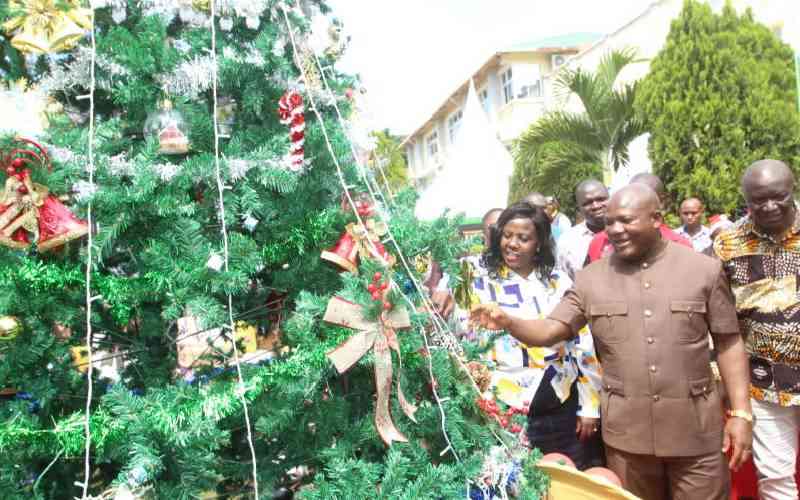 |
|
Nyeri residents look at a giant Mugumo tree, estimated to be more than 200 years-old, that fell in Ikumbo village in Giakanja area, Nyeri County. [Photo: John Gathua/Standard] |
By Job Weru
Nyeri, Kenya: To many people, the falling of a tree is a routine and natural occurrence. But to some villagers in Nyeri, when the fallen tree happens to be the sacred mugumo (Fig tree), then it symbolises something important.
And with the General Election around the corner, the falling of a mugumo tree has created debate in the county. Market centres are abuzz with news of the sacred tree, with some groups of elders from the village saying it signifies a generational change in county leadership. According to the talk, the happening at Giakanja village can be described as ituika, a word that means change of guard from one age group to the other.
It was in Samuel Wang’ondu’s homestead that the famous tree tumbled. “It came as a surprise when we saw what had happened to the tree,” said Wang’ondu who said the tree could be more than 200 years-old. What has elicited debate in the village and county is the belief in Kikuyu culture that falling of a Mugumo tree is referred to as ituika, which means change of guard or an end of a dynasty.
With many locals believing that Deputy Prime Minister Uhuru Kenyatta has a chance to succeed President Kibaki, the falling of the tree may not just be an ordinary happening. What is not clear in the villagers’ minds is whether Uhuru would succeed Kibaki as the community leader or as president.
Fresh twist
There is also a twist in the story, with some claiming it symbolised the defeat of the immediate former MP F T Nyammo who was fell to James Githinji, a political greenhorn.
A Kikuyu elder, Harisson Kanyuguto, said ituika occurs whenever the elderly are handing over leadership to the younger generation or vice versa. “Whenever it occurs, celebrations are conducted and sacrifices given. Another mugumo tree is planted at the scene of the fallen tree,” said Kanyuguto.
Gikuyu and Mumbi Cultural Museum Executive Director Samuel Kamitha told The Standard that whenever a mugumo tree fell in Gikuyu land; it had a meaning to the community. Kamitha notes that in 1963, a huge mugumo tree fell in Thika, and this led to the exit of colonialists, who were being fought by a local group, the Mau Mau. The Thika tree, according to Kamitha and a Kikuyu elder, Wanjohi Waweru, was also prophesied by Kikuyu prophet Mugo wa Kibiru.
“Mugo prophesied that the fall of a giant mugumo tree in Thika would symbolise the end of European rule in Kenya,” said Waweru, who is also an hotelier. When the British Colonial Government learnt of the prophecy, they built an iron ring around it to prevent it from falling. “In 1963, the tree split and fell in two parts, hence leading to an independent Kenya led by Mzee Jomo Kenyatta,” said Waweru.
Mr Danson Kamanja, a resident of Thika, said the iron ring still exists at the base of the fallen tree that forced out the white rulers. The traditionalist adds that in 1978, another mugumo tree fell in Chania, leading to the death of founding President Jomo Kenyatta.
Ample shade
Mr Samuel Wang’ondu, who owns the land in which the Giakanja tree fell said in 2002, a giant Mugumo tree that used to offer an ample shade to mitumba (second hand) traders in Nyeri’s Dedan Kimathi Grounds, fell after heavy rains pounded the area. “No injuries were reported, but later on, then opposition leader and Othaya MP Mwai Kibaki was elected President and handed over power by his predecessor, Daniel arap Moi,” said Wang’ondu.
His brother, 70-year-old Gichuki Irungu, who claimed that the tree is more than 200 years old, said when he was a young man his ageing grandfather revealed that when he was growing up the tree was still mature. In Kikuyu traditions, a mugumo tree is sacred and one cannot cut it down for firewood or for whatever purposes.
It is the same tree that Kikuyu forefathers used as a shrine to make sacrifices to Mwene Nyaga (God of Kirinyaga) or as venues during prayers. A mugumo tree cannot be felled and it is left to grow as old as it can.
Stay informed. Subscribe to our newsletter
 The Standard Group Plc is a
multi-media organization with investments in media platforms spanning newspaper
print operations, television, radio broadcasting, digital and online services. The
Standard Group is recognized as a leading multi-media house in Kenya with a key
influence in matters of national and international interest.
The Standard Group Plc is a
multi-media organization with investments in media platforms spanning newspaper
print operations, television, radio broadcasting, digital and online services. The
Standard Group is recognized as a leading multi-media house in Kenya with a key
influence in matters of national and international interest.
 The Standard Group Plc is a
multi-media organization with investments in media platforms spanning newspaper
print operations, television, radio broadcasting, digital and online services. The
Standard Group is recognized as a leading multi-media house in Kenya with a key
influence in matters of national and international interest.
The Standard Group Plc is a
multi-media organization with investments in media platforms spanning newspaper
print operations, television, radio broadcasting, digital and online services. The
Standard Group is recognized as a leading multi-media house in Kenya with a key
influence in matters of national and international interest.






